Forest Aboveground Biomass Estimation Using Multisource Remote Sensing Data and Deep Learning Algorithms: A Case Study over Hangzhou Area in China
Abstract
:1. Introduction
2. Materials and Methods
2.1. Study Area
2.2. Data Collection and Processing
2.2.1. Field Data
2.2.2. Optical and SAR Data Processing
2.3. Characteristic Variable Selection
2.4. Experimental Models
2.4.1. Random Forest
2.4.2. Convolutional Neural Network (CNN)
2.4.3. CNN-LSTM
2.5. Model Accuracy Assessment
3. Results
3.1. Predicted Variables
3.2. Model Test Results
3.3. Mapping Spatial Distribution of Forest
4. Discussion
4.1. Variable Selection
4.2. Comparison of Different Sensors
4.3. Model Comparison
5. Conclusions
Author Contributions
Funding
Data Availability Statement
Acknowledgments
Conflicts of Interest
References
- Zhang, F.; Tian, X.; Zhang, H.; Jiang, M. Estimation of Aboveground Carbon Density of Forests Using Deep Learning and Multisource Remote Sensing. Remote Sens. 2022, 14, 3022. [Google Scholar] [CrossRef]
- Fu, Y. Aboveground biomass estimation and uncertainties assessing on regional scale with an improved model analysis method. Hubei For. Sci. Technol. 2018, 47, 1–4. [Google Scholar]
- Zhang, X.; Tian, X.; Chen, E.; He, Q. A review of forest above-ground biomass estimation methods. J. Beijing For. Univ. 2011, 33, 144–150. [Google Scholar] [CrossRef]
- Chen, L.; Wang, Y.; Ren, C.; Zhang, B.; Wang, Z. Assessment of multi-wavelength SAR and multispectral instrument data for forest aboveground biomass mapping using random forest kriging. For. Ecol. Manag. 2019, 447, 12–25. [Google Scholar] [CrossRef]
- Wu, J.; Fu, G. Modelling aboveground biomass using MODIS FPAR/LAI data in alpine grasslands of the Northern Tibetan Plateau. Remote Sens. Lett. 2018, 9, 150–159. [Google Scholar] [CrossRef]
- Li, R.; Liu, J. Application of LandsatETM data to estimate the biomass of wet vegetation in Poyang Lake. J. Geogr. 2001, 56, 531–539. [Google Scholar]
- Silva, C.A.; Saatchi, S.; Garcia, M.; Labrière, N.; Klauberg, C.; Ferraz, A.; Meyer, V.; Jeffery, K.J.; Abernethy, K.; White, L.; et al. Comparison of Small- and Large-Footprint Lidar Characterization of Tropical Forest Aboveground Structure and Biomass: A Case Study from Central Gabon. IEEE J. Sel. Top. Appl. Earth Obs. Remote Sens. 2018, 11, 3512–3526. [Google Scholar] [CrossRef]
- Ali, I.; Cawkwell, F.; Dwyer, E.; Green, S. Modeling Managed Grassland Biomass Estimation by Using Multitemporal Remote Sensing Data—A Machine Learning Approach. IEEE J. Sel. Top. Appl. Earth Obs. Remote Sens. 2017, 10, 3254–3264. [Google Scholar] [CrossRef]
- Shao, Z.; Zhang, L.; Wang, L. Stacked Sparse Autoencoder Modeling Using the Synergy of Airborne LiDAR and Satellite Optical and SAR Data to Map Forest Above-Ground Biomass. IEEE J. Sel. Top. Appl. Earth Obs. Remote Sens. 2017, 10, 5569–5582. [Google Scholar] [CrossRef]
- Zheng, D.; Rademacher, J.; Chen, J.; Crow, T.; Bresee, M.; Moine, J.L.; Ryu, S.R. Estimating aboveground biomass using Landsat 7 ETM+ data across a managed landscape in northern Wisconsin, USA. Remote Sens. Environ. 2004, 93, 402–411. [Google Scholar] [CrossRef]
- Yue, J.; Yang, G.; Feng, H. Comparative of remote sensing estimation models of winter wheat biomass based on random forest algorithm. Trans. Chin. Soc. Agric. Eng. 2016, 32, 175–182. [Google Scholar]
- Zhou, R.; Zhao, T.; Wu, F. Aboveground Biomass Model Based on Landsat-8 Remote Sensing Images. J. Northwest For. Univ. 2022, 37, 186–192. [Google Scholar]
- Aguirre-Salado, C.A.; Trevino-Garza, E.J.; Aguirre-Calderon, O.A.; Jimenez-Perez, J.; Gonzalez-Tagle, M.A.; Valdez-Lazalde, J.R.; Sanchez-Diaz, G.; Haapanen, R.; Aguirre-Salado, A.I.; Miranda-Aragon, L. Mapping aboveground biomass by integrating geospatial and forest inventory data through a k-nearest neighbor strategy in North Central Mexico. J. Arid. Land 2014, 6, 80–96. [Google Scholar] [CrossRef]
- Hong, Y.; Xu, J.; Wu, C.; Pang, Y.; Zhang, S.; Chen, D.; Yang, B. Combining Multisource Data and Machine Learning Approaches for Multiscale Estimation of Forest Biomass. Forests 2023, 14, 2248. [Google Scholar] [CrossRef]
- Singh, C.; Karan, S.L.; Sardar, P.; Samadder, S.R. Remote sensing-based biomass estimation of dry deciduous tropical forest using machine learning and ensemble analysis. J. Environ. Manag. 2022, 308, 114639. [Google Scholar] [CrossRef] [PubMed]
- Guerra-Hernández, J.; Narine, L.L.; Pascual, A.; Gonzalez-Ferreiro, E.; Botequim, B.; Malambo, L.; Neuenschwander, A.; Popescu, S.C.; Godinho, S. Aboveground biomass mapping by integrating ICESat-2, SENTINEL-1, SENTINEL-2, ALOS2/ PALSAR2, and topographic information in Mediterranean forests. GIScience Remote Sens. 2022, 59, 1509–1533. [Google Scholar] [CrossRef]
- Nandy, S.; Srinet, R.; Padalia, H. Mapping forest height and aboveground biomass by integrating ICESat-2, Sentinel-1 and Sentinel-2 data using random forest algorithm in northwest Himalayan foothills of India. Geophys. Res. Lett. 2021, 48, e2021GL093799. [Google Scholar] [CrossRef]
- Shendryk, Y. Fusing GEDI with earth observation data for large area aboveground biomass mapping. Int. J. Appl. Earth Obs. Geoinf. 2022, 115, 103108. [Google Scholar] [CrossRef]
- Schreiber, L.V.; Amorim, J.G.A.; Guimaraes, L.; Matos, D.M.; da Costa, C.M.; Parraga, A. Above-ground Biomass Wheat Estimation: Deep Learning with UAV-based RGB Images. Appl. Artif. Intell. 2022, 36, 2055392. [Google Scholar] [CrossRef]
- Ghosh, S.M.; Behera, M.D. Aboveground biomass estimates of tropical mangrove forest using Sentinel-1 SAR coherence data—The superiority of deep learning over a semi-empirical model. Comput. Geosci. 2021, 150, 104737. [Google Scholar] [CrossRef]
- Narine, L.L.; Popescu, S.C.; Malambo, L. Synergy of ICESat-2 and Landsat for Mapping Forest Aboveground Biomass with Deep Learning. Remote Sens. 2019, 11, 1503. [Google Scholar] [CrossRef]
- Tian, L.; Wu, X.; Tao, Y.; Li, M.; Qian, C.; Liao, L.; Fu, W. Review of Remote Sensing-Based Methods for Forest Aboveground Biomass Estimation: Progress, Challenges, and Prospects. Forests 2023, 14, 1086. [Google Scholar] [CrossRef]
- Zhu, Y.; Feng, Z.; Lu, J.; Liu, J. Estimation of Forest Biomass in Beijing (China) Using Multisource Remote Sensing and Forest Inventory Data. Forests 2020, 11, 163. [Google Scholar] [CrossRef]
- Chrysafis, I.; Mallinis, G.; Siachalou, S.; Patias, P. Assessing the relationships between growing stock volume and Sentinel-2 imagery in a Mediterranean forest ecosystem. Remote Sens. Lett. 2017, 8, 508–517. [Google Scholar] [CrossRef]
- Jiang, F.; Sun, H.; Li, C.; Ma, K.; Chen, S.; Long, J.; Ren, L. Retrieving the forest aboveground biomass by combining the red edge bands of Sentinel-2 and GF-6. Acta Ecol. Sin. 2021, 41, 8222–8236. [Google Scholar] [CrossRef]
- Laurin, G.V.; Balling, J.; Corona, P.; Mattioli, W.; Papale, D.; Puletti, N.; Rizzo, M.; Truckenbrodt, J.; Urban, M. Above-ground biomass prediction by Sentinel-1 multitemporal data in central Italy with integration of ALOS2 and Sentinel-2 data. J. Appl. Remote Sens. 2018, 12, 016008. [Google Scholar] [CrossRef]
- Pan, L.; Sun, Y.; Wang, Y. Estimation of aboveground biomass in a Chinese fir (Cunninghamia lanceolata) forest combining data of Sentinel-1 and Sentinel-2. J. Nanjing For. Univ. (Nat. Sci. Ed.) 2020, 44, 149–156. [Google Scholar]
- Shi, J.; Zhang, W.; Zeng, P.; Zhao, L.; Wang, M. Inversion of forest aboveground biomass from combined images of GF-1 and GF-3. J. Beijing For. Univ. 2022, 44, 70–81. [Google Scholar]
- Pan, J. A Method for Estimating Above-Ground Forest Biomass by Combining GF-3 PolSAR Data and LANDSAT-8 OLI Data; Northeast Forestry University: Harbin, China, 2020. [Google Scholar]
- Breidenbach, J.; Waser, L.T.; Debella-Gilo, M.; Schumacher, J.; Rahlf, J.; Hauglin, M.; Puliti, S.; Astrup, R. National mapping and estimation of forest area by dominant tree species using Sentinel-2 data. Can. J. For. Res. 2020, 51, 365–379. [Google Scholar] [CrossRef]
- Ndikumana, E.; Minh, D.H.T.; Nguyen, H.T.D.; Baghdadi, N.; Courault, D.; Hossard, L.; El Moussawi, I. Estimation of Rice Height and Biomass Using Multitemporal SAR Sentinel-1 for Camargue, Southern France. Remote Sens. 2018, 10, 1394. [Google Scholar] [CrossRef]
- Jiang, M.; Guarnieri, A.M. Distributed scatterer interferometry with the refinement of spatiotemporal coherence. IEEE Trans. Geosci. Remote Sens. 2020, 58, 3977–3987. [Google Scholar] [CrossRef]
- Zhang, X.; Chan, N.W.; Pan, B.; Ge, X.; Yang, H. Mapping flood by the object-based method using backscattering coefficient and interference coherence of Sentinel-1 time series. Sci. Total Environ. 2021, 794, 148388. [Google Scholar] [CrossRef]
- Wang, X.; Chen, Y. A CNN-LSTM-based method for predicting the average speed of vehicles on urban roads. J. Qingdao Univ. Technol. 2023, 44, 117–126+140. [Google Scholar]
- Sinha, S.; Santra, A.; Sharma, L.; Jeganathan, C.; Nathawat, M.S.; Das, A.K.; Mohan, S. Multi-polarized Radarsat-2 satellite sensor in assessing forest vigor from above ground biomass. J. For. Res. 2018, 29, 1139–1145. [Google Scholar] [CrossRef]
- Minh, D.H.T.; Le Toan, T.; Rocca, F.; Tebaldini, S.; Villard, L.; Rejou-Mechain, M.; Phillips, O.L.; Feldpausch, T.R.; Dubois-Fernandez, P.; Scipal, K.; et al. SAR tomography for the retrieval of forest biomass and height: Cross-validation at two tropical forest sites in French Guiana. Remote Sens. Environ. 2016, 175, 138–147. [Google Scholar] [CrossRef]
- Kumar, L.; Sinha, P.; Taylor, S.; Alqurashi, A.F. Review of the use of remote sensing for biomass estimation to support renewable energy generation. J. Appl. Remote Sens. 2015, 9, 097696. [Google Scholar] [CrossRef]
- Sinha, S.; Jeganathan, C.; Sharma, L.K.; Nathawat, M.S. A review of radar remote sensing for biomass estimation. Int. J. Environ. Sci. Technol. 2015, 12, 1779–1792. [Google Scholar] [CrossRef]
- Michelakis, D.; Stuart, N.; Brolly, M.; Woodhouse, I.H.; Lopez, G.; Linares, V. Estimation of Woody Biomass of Pine Savanna Woodlands from ALOS PALSAR Imagery. IEEE J. Sel. Top. Appl. Earth Obs. Remote Sens. 2015, 8, 244–254. [Google Scholar] [CrossRef]
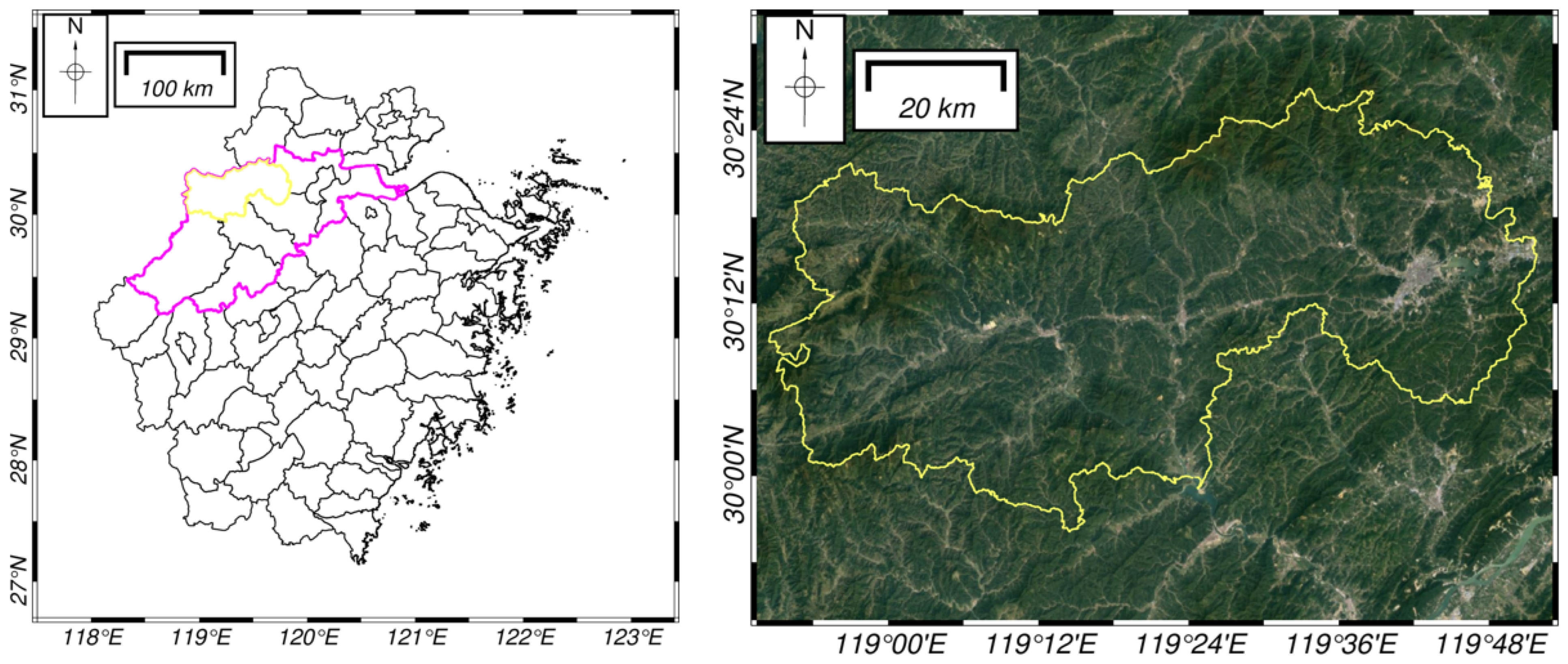
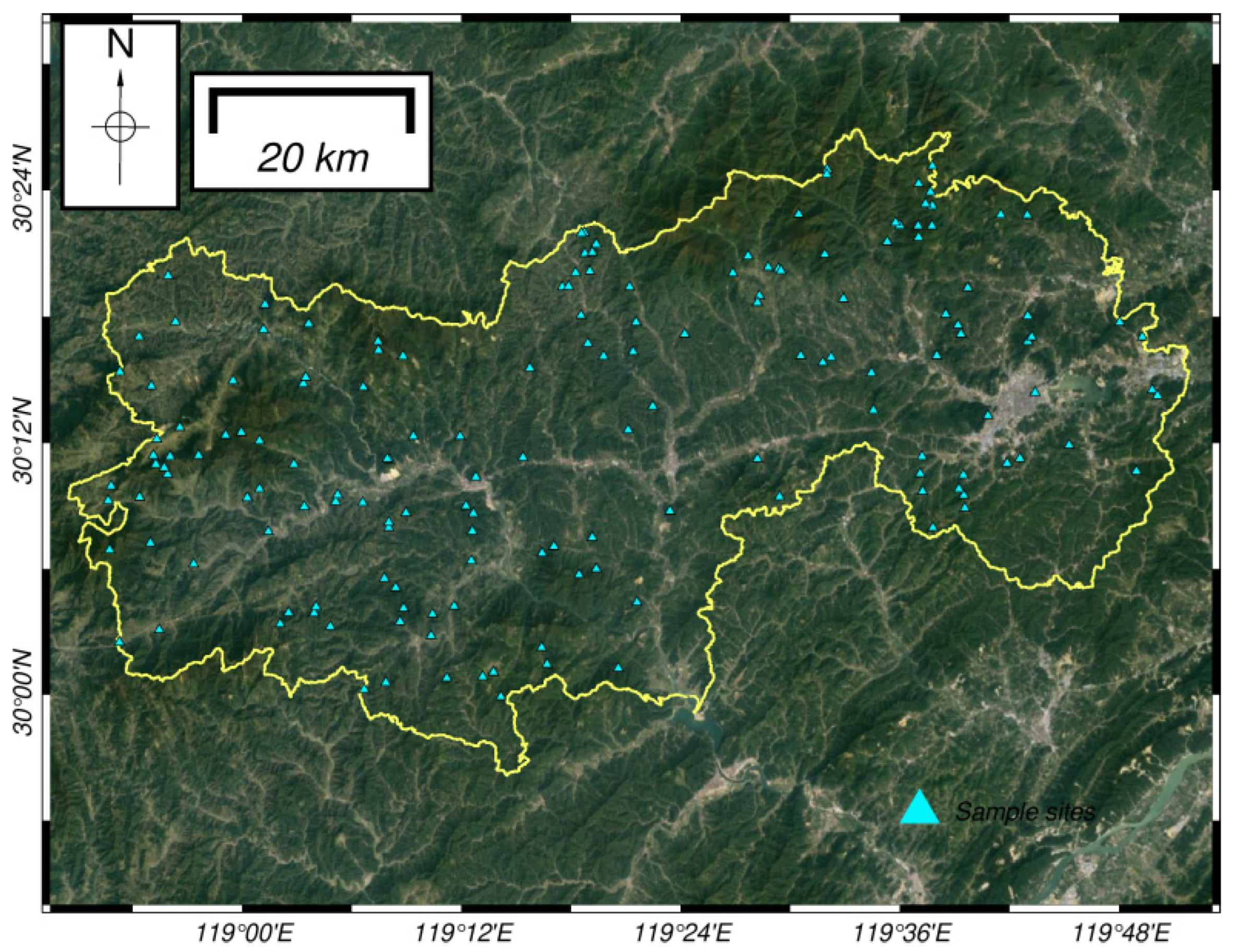
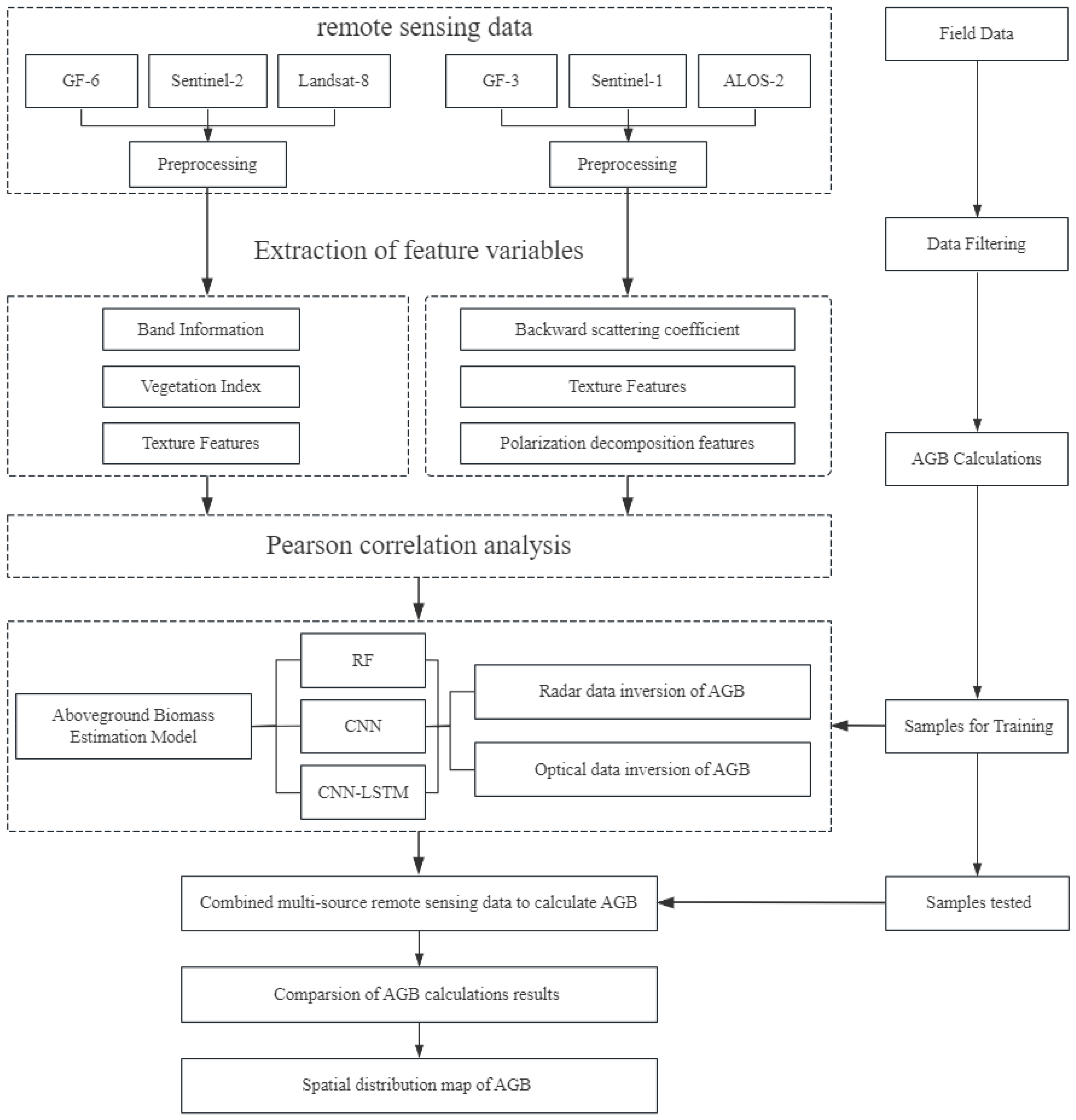

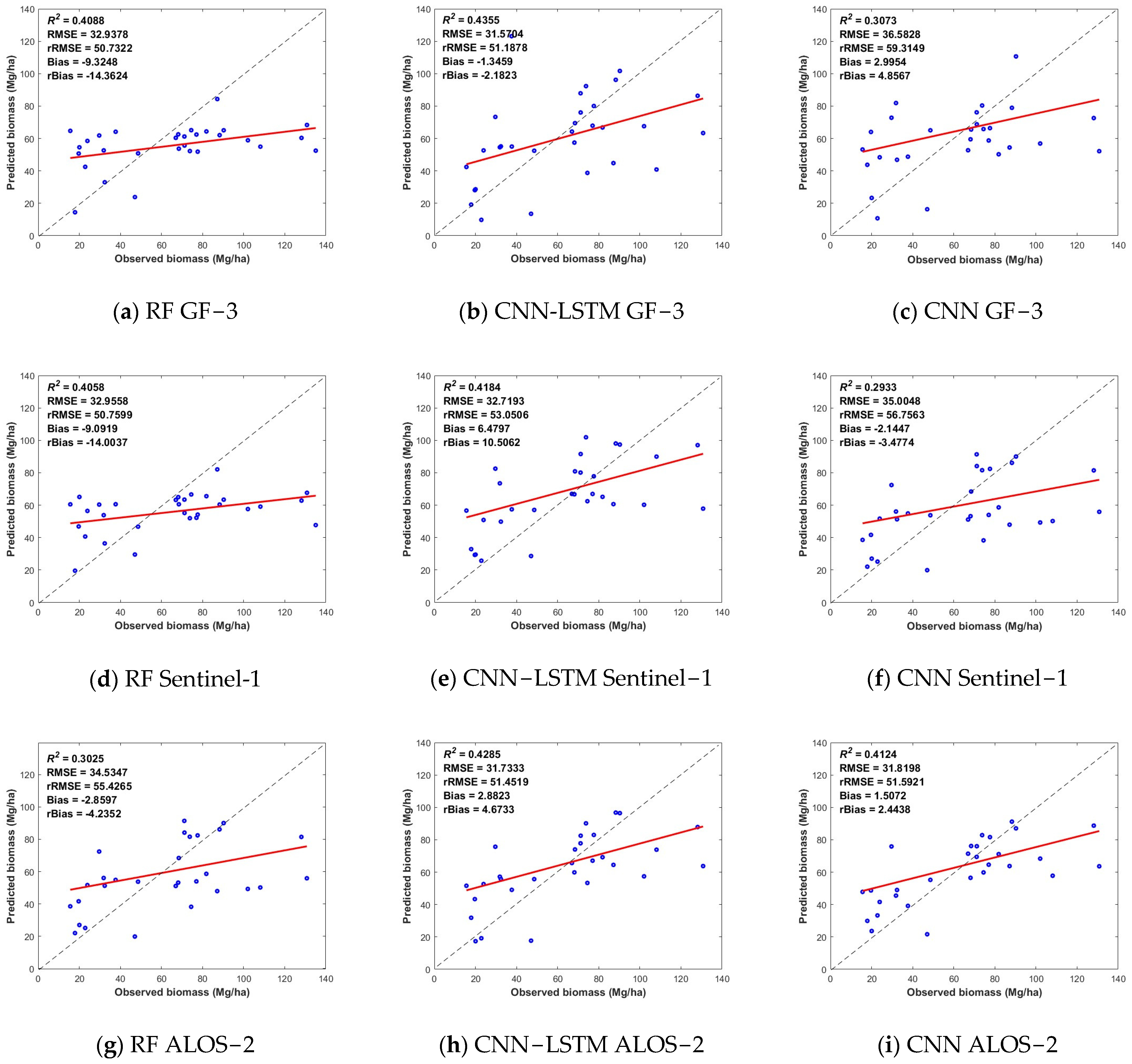
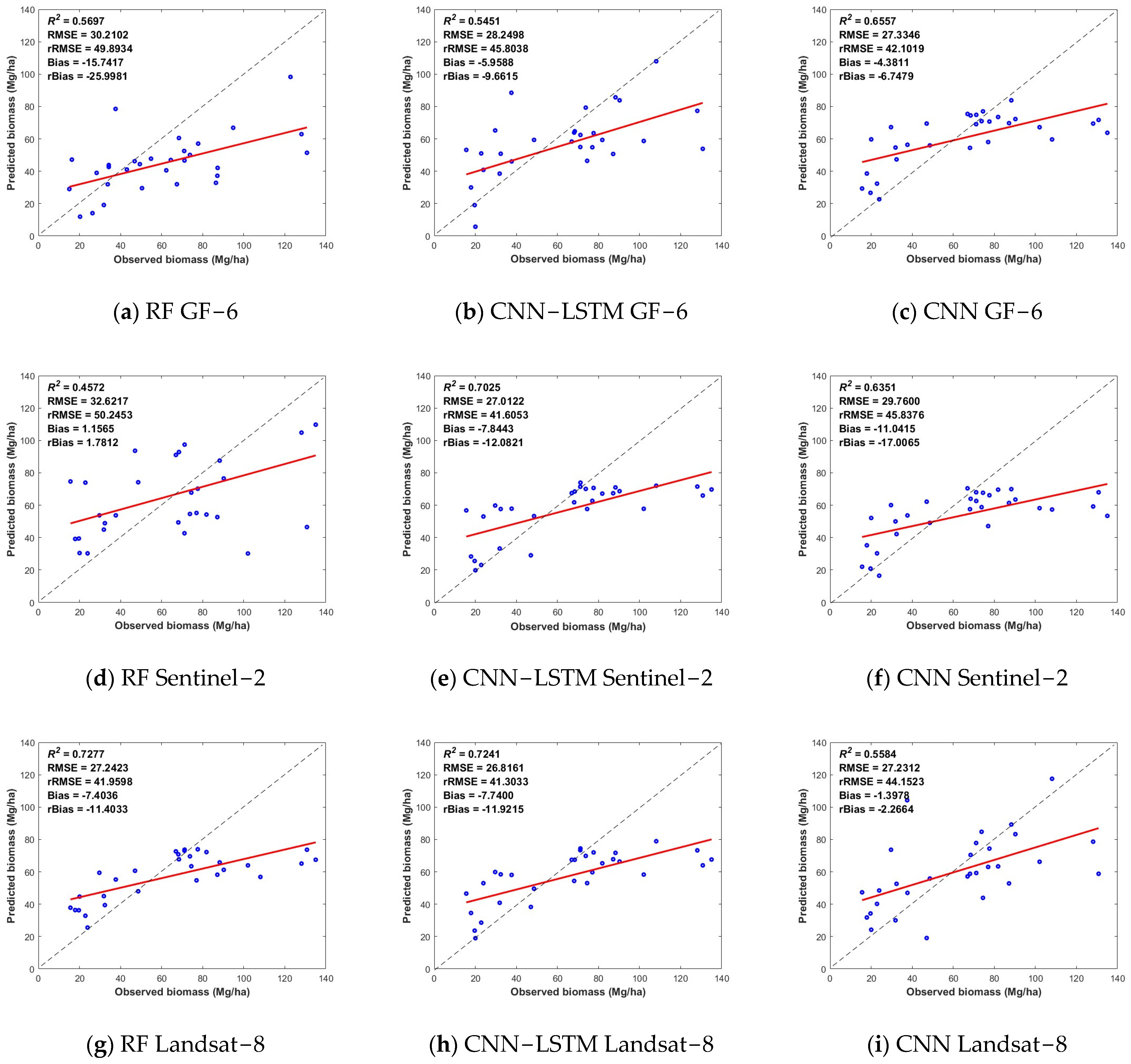



| Tree Species | Model Expressions and Parameters |
|---|---|
| Fir (Cunninghamia lanceolata (Lamb.) Hook., belonging to the Cupressaceae) | |
| Horsetail pine (Pinus massoniana Lamb. belonging to the Pinaceae) | |
| Hard broad | |
| Soft broad |
| Optical Data | Data Identification | Collection Time | Product Level | Spatial Resolution |
|---|---|---|---|---|
| GF-6 | GF6_WFV_E118.4_N29.1_20180905_L1A1119836975 | 2018.9.5 | L1A | 16 m |
| Sentinel-2 | S2B_MSIL1C_20181029T024819_N0206_R132_T50RPU_20181029T052535 | 2018.10.29 | Level-1C | visible: 10 m near-infrared: 20 m shortwave infrared: 60 m |
| S2A_MSIL1C_20181110T023921_N0207_R089_T50RQU_20181110T042743 | 2018.11.10 | Level-1C | ||
| Landsat-8 | LC08_L1TP_120039_20181028_20181115_01_T1 | 2018.11.15 | L1T | Bands 1–7, 9–11: 30 m band 8: 15 m |
| LC08_L1TP_119039_20180911_20180920_01_T1 | 2018.9.11 | L1T |
| Image Type | Acquisition Time | Product Level | Band | Polarization | Spatial Resolution |
|---|---|---|---|---|---|
| GF-3 | 17 November 2018 | L1A | C band | HH + HV | 1 m |
| Sentinel-1 | 1 October 2018 13 October 2018 | Level-1 | C band | VV + VH | IW: 5 × 20 m |
| ALOS-2 PALSAR-2 | 25 October 2018 8 November 2018 | Level 1.5 | L band | HH + HV | Spotlight: 1–3 m Stripmap: 3–10 m ScanSAR: 25–100 m |
| Variable Type | Name | Description |
|---|---|---|
| Band Information | GF-6 | B1, 2, 3, 4, 5, 6 |
| Sentinel-2 | B2, 3, 4, 5, 6, 7, 8, 8a, 11, 12 | |
| Landsat-8 | B2, 3, 4, 5, 6, 7 | |
| Vegetation Index | NDVI | NDVI = (NIR − R)/(NIR + R) |
| DVI | DVI = NIR −R | |
| GNDV | GNDV = (NIR − G)/(NIR + G) | |
| RVI | RVI = NIR/R |
| Number | Texture Feature Name | Introduction to the Formula |
|---|---|---|
| 1 | Mean | |
| 2 | Variance | |
| 3 | Entropy | |
| 4 | Contrast | |
| 5 | Homogeneity | |
| 6 | Dissimilarity | |
| 7 | Correlation | |
| 8 | Second Moment |
| Image Data Source | Feature Type | Remote Sensing Predictors | |
|---|---|---|---|
| GF-3, Sentinel-1, ALOS-2 | Backward scattering coefficient | GF-3, ALOS-2 | HH, HV |
| Sentinel-1 | VV, VH | ||
| Texture features | Mean, Variance, Entropy, Contrast, Homogeneity, Dissimilarity, Correlation, Second Moment | ||
| Polarization decomposition features | H, A, α | ||
| Image | Category | Variables | Pearson’s Correlation Coefficient | Variables | Pearson’s Correlation Coefficient |
|---|---|---|---|---|---|
| GF-3 | Backward scattering coefficient | HH | 0.069 | HV | 0.074 |
| Texture feature factor | HH_Mean | 0.051 | HV_Mean | 0.107 | |
| HH_Variance | 0.052 | HV_Variance | 0.107 | ||
| HH_Entropy | 0.065 | HV_Entropy | 0.107 | ||
| HH_Contrast | 0.067 | HV_Contrast | 0.048 | ||
| HH_Homogeneity | −0.058 | HV_Homogeneity | −0.098 | ||
| HH_Dissimilarity | 0.066 | HV_Dissimilarity | 0.107 | ||
| HH_Correlation | 0.029 | HV_Correlation | −0.064 | ||
| HH_Second moment | −0.032 | HV_Second moment | −0.127 | ||
| Polarization decomposition parameter | H | 0.271 | A | −0.258 | |
| α | 0.246 | ||||
| Sentinel-1 | Backscattering coefficient | VV | −0.002 | VH | 0.062 |
| Texture characteristic factor | VV_Mean | −0.028 | VH_Mean | −0.037 | |
| VV_Variance | −0.039 | VH_Variance | −0.083 | ||
| VV_Entropy | −0.013 | VH_Entropy | −0.013 | ||
| VV_Contrast | 0.32 | VH_Contrast | −0.079 | ||
| VV_Homogeneity | −0.013 | VH_Homogeneity | −0.029 | ||
| VV_Dissimilarity | 0.021 | VH_Dissimilarity | −0.006 | ||
| VV_Correlation | −0.077 | VH_Correlation | −0.037 | ||
| VV_Second moment | 0.019 | VH_Second moment | −0.017 | ||
| Polarization decomposition parameter | H | 0.241 | A | −0.238 | |
| α | 0.226 | ||||
| ALOS-2 PALSAR-2 | Backscattering coefficient | HH | −0.024 | HV | 0.079 |
| Texture factor | HH_Mean | −0.017 | HV_Mean | 0.082 | |
| HH_Variance | −0.005 | HV_Variance | −0.034 | ||
| HH_Entropy | −0.013 | HV_Entropy | −0.077 | ||
| HH_Contrast | −0.005 | HV_Contrast | 0.015 | ||
| HH_Homogeneity | −0.013 | HV_Homogeneity | 0.040 | ||
| HH_Dissimilarity | −0.004 | HV_Dissimilarity | −0.007 | ||
| HH_Correlation | −0.045 | HV_Correlation | 0.006 | ||
| HH_Second moment | 0.031 | HV_Second moment | 0.053 | ||
| Polarization decomposition parameter | H | 0.312 | A | −0.319 | |
| α | 0.235 |
| Image | Selection of Characteristic Variables |
|---|---|
| GF-3 | HH_dB, HV_dB, HH_Contrast, H |
| Sentinel-1 | VH_dB, VH_Contrast, VH_Variance, A |
| ALOS-2 PALSAR-2 | HV_dB, HV_Entropy, HV_Mean, H |
| Image | Category | Feature Variable | Pearson’s Correlation Coefficient | Feature Variable | Pearson’s Correlation Coefficient |
|---|---|---|---|---|---|
| GF-6 | Band information | B1 | 0.080 | B2 | 0.036 |
| B3 | 0.020 | B4 | −0.131 | ||
| B5 | −0.118 | B6 | −0.092 | ||
| Vegetation index | NDVI | 0.091 | DVI | −0.128 | |
| GNDV | 0.01 | RVI | 0.206 | ||
| Texture factors | Mean | 0.084 | Variance | 0.141 | |
| Entropy | −0.048 | Contrast | 0.122 | ||
| Homogeneity | 0.006 | Dissimilarity | 0.041 | ||
| Correlation | 0.069 | Second moment | 0.083 | ||
| Principal component analysis | PCA1 | 0.090 | PCA2 | 0.066 | |
| PCA3 | 0.343 | ||||
| Sentinel-2 | Band information | B2 | −0.291 | B3 | −0.332 |
| B4 | −0.374 | B5 | −0.377 | ||
| B6 | −0.225 | B7 | −0.12 | ||
| B8 | −0.157 | B8a | −0.138 | ||
| B11 | −0.330 | B12 | −0.422 | ||
| Vegetation index | NDVI | 0.282 | DVI | 0.075 | |
| GNDV | 0.117 | RVI | 0.249 | ||
| Texture factors | Mean | −0.405 | Variance | −0.111 | |
| Entropy | −0.216 | Contrast | −0.180 | ||
| Homogeneity | Dissimilarity | −0.182 | |||
| Correlation | −0.136 | Second moment | 0.155 | ||
| Principal component analysis | PCA1 | −0.275 | PCA2 | −0.368 | |
| PCA3 | 0.420 | ||||
| Landsat-8 | Band information | B2 | −0.273 | B3 | −0.402 |
| B4 | −0.472 | B5 | −0.173 | ||
| B6 | B7 | −0.464 | |||
| Vegetation index | NDVI | 0.273 | DVI | −0.028 | |
| GNDV | 0.273 | RVI | 0.396 | ||
| Texture factors | Mean | −0.348 | Variance | −0.260 | |
| Entropy | −0.398 | Contrast | −0.211 | ||
| Homogeneity | 0.360 | Dissimilarity | −0.324 | ||
| Correlation | 0.064 | Second moment | 0.374 | ||
| Principal component analysis | PCA1 | −0.381 | PCA2 | −0.371 | |
| PCA3 | −0.406 |
| Image | Selection of Characteristic Variables |
|---|---|
| GF-6 | B4, B5, B6, Contrast, Variance, RVI, GNDV, PCA3 |
| Sentinel-2 | B3, B4, B5, B12, Entropy, Mean, NDVI, PCA3 |
| Landsat-8 | B3, B4, B7, Second, Entropy, NDVI, RVI, PCA3 |
| Remote Sensing Data | Estimation Methods | RMSE | R2 |
|---|---|---|---|
| GF-3 | RF | 32.9378 | 0.4088 |
| CNN | 36.5828 | 0.3073 | |
| CNN-LSTM | 31.5704 | 0.4355 | |
| Sentinel-1 | RF | 32.9558 | 0.4058 |
| CNN | 35.0048 | 0.2933 | |
| CNN-LSTM | 32.7193 | 0.4184 | |
| ALOS-2 | RF | 34.5347 | 0.3025 |
| CNN | 31.8198 | 0.4124 | |
| CNN-LSTM | 31.7333 | 0.4285 |
| Image | Selection of Feature Variables |
|---|---|
| GF-3 | HV_dB, HH_Contrast, H |
| Sentinel-1 | VH_dB, VH_Variance, A |
| ALOS-2 PALSAR-2 | HV_dB, HV_Mean, H |
| GF-6 | B5, Variance, RVI, PCA3 |
| Sentinel-2 | Mean, B12, B5, PCA3 |
| Landsat-8 | B4, Entropy, RVI, PCA3 |
Disclaimer/Publisher’s Note: The statements, opinions and data contained in all publications are solely those of the individual author(s) and contributor(s) and not of MDPI and/or the editor(s). MDPI and/or the editor(s) disclaim responsibility for any injury to people or property resulting from any ideas, methods, instructions or products referred to in the content. |
© 2024 by the authors. Licensee MDPI, Basel, Switzerland. This article is an open access article distributed under the terms and conditions of the Creative Commons Attribution (CC BY) license (https://creativecommons.org/licenses/by/4.0/).
Share and Cite
Tian, X.; Li, J.; Zhang, F.; Zhang, H.; Jiang, M. Forest Aboveground Biomass Estimation Using Multisource Remote Sensing Data and Deep Learning Algorithms: A Case Study over Hangzhou Area in China. Remote Sens. 2024, 16, 1074. https://doi.org/10.3390/rs16061074
Tian X, Li J, Zhang F, Zhang H, Jiang M. Forest Aboveground Biomass Estimation Using Multisource Remote Sensing Data and Deep Learning Algorithms: A Case Study over Hangzhou Area in China. Remote Sensing. 2024; 16(6):1074. https://doi.org/10.3390/rs16061074
Chicago/Turabian StyleTian, Xin, Jiejie Li, Fanyi Zhang, Haibo Zhang, and Mi Jiang. 2024. "Forest Aboveground Biomass Estimation Using Multisource Remote Sensing Data and Deep Learning Algorithms: A Case Study over Hangzhou Area in China" Remote Sensing 16, no. 6: 1074. https://doi.org/10.3390/rs16061074
APA StyleTian, X., Li, J., Zhang, F., Zhang, H., & Jiang, M. (2024). Forest Aboveground Biomass Estimation Using Multisource Remote Sensing Data and Deep Learning Algorithms: A Case Study over Hangzhou Area in China. Remote Sensing, 16(6), 1074. https://doi.org/10.3390/rs16061074







